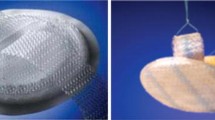Abstract
Purpose
The biological responses to mesh in vivo have been evaluated in some papers, but the in vivo condition of mesh and plugs have not been sufficiently evaluated. This study evaluated the endoscopic observations and histological assessments of mesh plugs using swine models.
Methods
An artificial abdominal hernia was established in the porcine abdomen, and repaired using three different sizes of two types of plug, Proloop (ATRIUM Medical Corporation, Hudson, NH, USA) or Perfix (BARD Medical Division, Covington, GA, USA). The in vivo conditions of each plug were periodically observed using a laparoscope. Moreover, a histological evaluation of the plugs was performed 3 months after implantation.
Results
The laparoscopic observation revealed that inversion of the plugs occurred in 10 out of 18 cases repaired with Perfix, while no case repaired with Proloop inverted. The large and medium sizes of Perfix plugs were inclined by an average of more than 30°. In addition, the triangular shape of Perfix plugs was broken and the vertical/horizontal ratio was enlarged during the observation period, while Proloop plugs shrank both vertically and horizontally. The inflammatory cell count was significantly lower within the Proloop plugs than within Perfix plugs.
Conclusion
Proloop plugs are apparently superior because they are stable even 3 months after implantation.
Similar content being viewed by others
References
Klosterhalfern B, Klinge U, Hermanns U, Schumpelick V. Pathology of traditional surgical nets for hernia repair after long-term implantation in humans. Chirurg 2000;71:43–51.
Klinge U, Klosterhalfen U, Birkenhauer V, Junge K, Conze J, Schumpelick V. Impact of polymer pore size on the interface scar formation in a rat model. J Surg Res 2002;103:208–214.
Schumpelick V, Klinge U, Welty G, Klosterhalfen B. Meshes in the abdominal wall. Chirurg 1999;70:876–887.
Rosch R, Junge K, Schachtrupp A, Klinge U, Klosterhalfen B, Schumpelick V. Mesh implants in hernia repair. Inflammatory cell response in a rat model. Eur Surg Res 2003;35:161–166.
Harrell AG, Novitsky YW, Cristiano JA, Gersin KS, Norton HJ, Kercher KW, et al. Prospective histologic evaluation of intraabdominal prosthetics four months after implantation in a rabbit model. Surg Endosc 2007;21:1170–1174.
Simons MP, Aufenacker T, Bay-Nielsen M, Bouillot JL, Campanelli G, Conze J, et al. European Hernia Society guidelines on the treatment of inguinal hernia in adult patients. Hernia 2009;13:343–403.
O’Dwyer PJ, Kingsnorth AN, Molloy RG, Small PK, Lammers B, Horeyseck G. Randomized clinical trial assessing impact of lightweight or heavyweight mesh on chronic pain after inguinal hernia repair. Br J Surg 2005;92:166–170.
Tamme C, Garde N, Klingler A, Hampe C, Wunder R, Kockerling F. Totally extraperitoneal inguinal hernioplasty with titaniumcoated lightweight hernia mesh: early results. Surg Endosc 2005;19:1125–1129.
Welty G, Klinge U, Klosterhalfen B, Kasperk R. Functional impairment and complaints following incisional hernia repair with different polypropylene mesh. Hernia 2001;5:142–147.
Klosterhalfen B, Junge K, Klinge U. The lightweight and large porous mesh concept for hernia repair. Expert Rev Med Devices 2005;2:103–117.
Weyhe D, Schmitz I, Belyaev O, Grabs R, Muller K-M, Uhl W, et al. Experimental comparison of monofile light and heavy polypropylene meshes: Less weight does not mean less biological response. World J Surg 2006;30:1586–1591.
Goldstein HS. Selecting the right mesh. Hernia 1999;1:23–26.
Bay-Nielsen M, Perkins FM, Kehlet H. Pain and functional impairment 1 year after inguinal herniorrhaphy: a nationwide questionnaire study. Ann Surg 2001;233(1):1–7.
Courtney CA, Duffy K, Serpell MG, O’Dwyer PJ. Outcome of patients with severe chronic pain following repair of groin hernia. Br J Surg 2002;89:1310–1314.
Pélissier EP, Blum D, Damas JM, Marre P. The plug method in inguinal hernia: a prospective evaluation. Hernia 1999;4:201–204.
Klinge U, Junge K, Stumpf M, Ottinger AP, Klosterhalfen B. Functional and morphological evaluation of a low-weight, monofilament polypropylene mesh for hernia repair. J Biomed Mater Res 2002;63:129–136.
Cobb WS, Kercher KW, Heniford BT. The argument for lightweight polypropylene mesh in hernia repair. Surg Innov 2005;12:63–69.
Klinge U, Klosterhalfen B, Conze J, Limberg W, Obolenski B, Ottinger AP, et al. Modified mesh for hernia repair that is adapted to the physiology of the abdominal wall. Eur J Surg 1998;164:951–960.
Schug-Pab C, Tamme C, Sommerer F, Tannapfel A. A lightweight, partially absorbable mesh (Ultrapro) for endoscopic hernia repair: experimental biocompatibility results obtained with a porcine model. Surg Endosc 2008;22:1100–1106.
Author information
Authors and Affiliations
Rights and permissions
About this article
Cite this article
Mandai, Y., Naito, M., Hayashi, T. et al. Impact of endoscopic and histological evaluations of two different types of mesh plug for a groin hernia model. Surg Today 41, 1512–1518 (2011). https://doi.org/10.1007/s00595-010-4520-9
Received:
Accepted:
Published:
Issue Date:
DOI: https://doi.org/10.1007/s00595-010-4520-9




